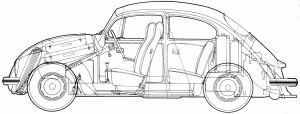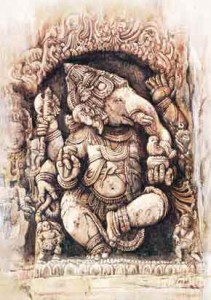|
 |
This story has been published by Jennifer Zaino’s in her article: Volkswagen: Das Auto Company is Das Semantic Web Company!
I can now talk about this project that uses some pieces of the framework that we have been developing for more than 3 years now.
The Objective
Volkswagen’s main objective behind the development of the next version of their Web platform started by improving their online search engine, but as William Greenly mentioned, it quickly became a strategic decision:
“So the objectives were about site search and improving it, but in the long-run it was always the idea to contextualize content, to facet content, to promote it in different contexts.â€
The objective is to create a platform that gives them the flexibility to leverage all the data assets they own. This flexibility will help them to leverage the data assests they have to improve not only their search engine, but also to contextualize it in different parts of their websites, partner’s websites or to promote, and publish that same information on different communication channels or devices.
The Flexibility
 |
What is a flexible platform in that context? A flexible platform is one that can integrate any kind of information sources. Such information sources in the context of Volkswagen can be a series of relational dataset schemas spread around the World, Excel spreadsheets, CSV files, old plain text technical documents about past model of cars, semi-structured documents such as webpages, etc. |
A flexible platform is also one that minimally impact (if at all) the data consumers if the data structure changes in the system. This is really important since the World we live in constantly changes. This means that things constantly change and we have to reflect these changes in the data we own and maintain. This is why this point is so important, because we want to minimize the impact of the data structure changes that will happen all the time.
Having the flexibility to constantly adapt your data, while minimally impacting the data consumers of the system, enables you to make quick decision to adapt your strategy in a highly competitive World. This flexibility gives you a clear business advantage.
A flexible platform is also one that let you publish your data the way you want, in the format that is needed. Such a flexible platform has to give you access to an interface that give you access to all the functionalities of the platform without having to care about what happens under the hood.
A flexible system is one that can communicate your information on any kind of communication channels, and to any devices that have access to the Web.
Under the Hood
That next generation platform that Volkswagen is currently developing is partly based on a few of the main pieces of the Open Semantic Framework. These pieces help them to reach their goal by helping them giving the flexibility their platform needs.
The first step they gone thru was to create their Volkswagen Vehicles Ontology that is used to describe all the entities they want to index into their platform. The Web Ontology Language (OWL), along with the Resource Description Framework (RDF) is what gives them the complete flexibility on how they can integrate all the pieces of information they want, in a canonical format.
| Then they choose to use structWSF (the structured data web services framework). This piece gives them the flexibility to get a series of web interfaces (web service endpoints) to create, update, manage and query their data. This web service layer enables them to do anything they want with their data, from anywhere on the Web. This is possible because all the functionalities of the framework are exposed as web service endpoints. StructWSF also gives them the possibility to communicate their data in multiple different formats. This makes it the perfect flexible system to feed their information in different contexts, in different communication channels or on different devices. |  |
At Volkswagen, structWSF is used to populate, and keep in sync, their Solr and Triple Store instances. It gives them the time to care about the more important aspects of their platform, and to care about how the data should be synced between the various specialized data management systems.
By using structWSF to manage their data, they are able to reach some objectives to make their platform as flexible as possible:
- To be able to minimize the impact of data changes to the data consumers
- Because structWSF uses OWL & RDF to describe all the data it index
- To be able to manipulate their data from anywhere
- Because all the functionalities of structWSF are exposed as web service endpoints
- To be able to communicate the information in different contexts, communication channels and devices
- Because structWSF has, in its core, is designed to transform all the data it indexes in any other kind of format
The Next Step
One of their longer term goal and objective is to analyze their unstructured and semi-structured textual documents to extract some structure out of them, and to index them into their semantic platform. To do this, they are looking at using Scones, which is the structWSF semantic tagger web service endpoint. Scones will use some subject reference structures such as UMBEL to semantically tag the textual document. Once the document as been processed by Scones, and indexed in structWSF, it can now be re-published in different contexts based on the reference concepts that have been tagged to it. This gives them the flexibility to leverage non-structured sources of data and to re-purpose it in different ways by publishing it in different context and in different systems.
This second system will enable them to leverage the investment they made in the past, by writing all these textual documents, and to re-purpose, and re-contextualizing, them in all kind of different contexts.
Conclusion
I think that TribalDDB and Volkswagen make the good decision for their future. Taking the business decision to develop and maintain a completely new kind of information system is not an easy decision to take. I am not saying that they made the good choice to use our pieces of the stack. The decision goes far beyond this. Such a Semantic Platform challenges everything in an organization: the people that takes the decisions, the people that create and manage the data, the people that develop the system, the people that maintain that system, the consumers of the system, the customers, the partners, etc. This is a big decision; whatever the technology stack you plan to use. I congratulate them for the decision they took.
I strongly believe that this was the right decision to take considering the future opportunities they are creating to themselves.

